The Next Era in Profitability is XLG
Experience-Led Growth (XLG) was coined by McKinsey in 2023. It describes how businesses can achieve sustained profitable growth by treating customer experience as their key competitive advantage. In this model, the best path to profitability is to figure out what matters most to your customers so they buy more from you and bring their friends along too.
And it’s about time - it is very clear that the business world has changed dramatically over the last couple of years. The era of growth at all costs powered by cheap money is over. Companies such as Peloton, Lyft, Farfetch, and many others that were once flying high have seen their share prices collapse, and some have even come close to bankruptcy.
Even if interest rates fall in the coming months, investors and business leaders have learned their lesson and now value sustainable, profitable growth above all else. Revenue growth itself is still very important, but now companies also need to prove they have unit economics that work to survive. The battle scars will teach a whole new generation of investors that profitability is not something to compromise on, even in boom times.
And yet, very few companies are prepared for the new reality. Too many have grown accustomed to plunging ever-increasing sums into buying growth, mainly through paid customer acquisition. It’s no surprise that a 2023 report by PWC found that 45% of CEOs think their organization will no longer be economically viable in ten years’ time if it continues on its current course.
That’s why XLG is so important. In this article, you’ll learn how XLG can drive profit throughout the customer journey, from customer acquisition to customer service. We’ll show you:
- The evolution of business growth strategies
- What the three big problems are with buying new customers
- How XLG helps you to succeed in a customer-first world
- The challenges of implementing XLG
- The three elements you need to accelerate XLG
The Evolution of Business Growth Strategies
But how did we get here? In the last 100 years, the way companies grow has evolved:
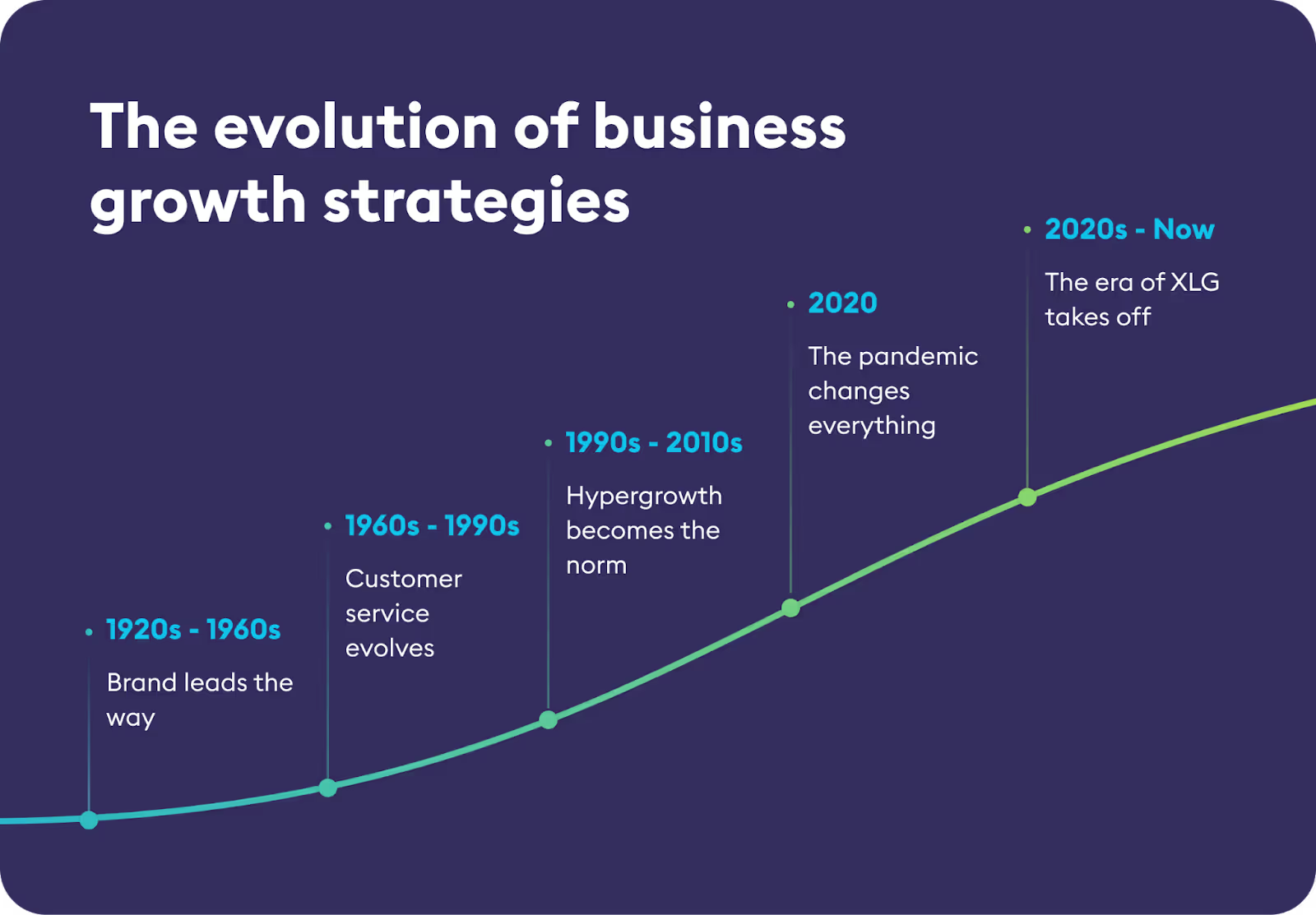
From the 1920s to the 1960s, the rise of broadcast media, such as TV and Radio brought advertising into people's homes. Visibility and an aspirational image meant commercial success. Brands competed with one another based on media spend.
As customer service evolved from the 1960s to 1990s, businesses began to focus on the end-to-end customer journey. Customer service became the standard as companies improved their products and service levels in order to keep up.
Hypergrowth became the norm from the 1990s to the 2010s when businesses like Airbnb, Paypal, and Uber realized that they could grow quickly by using investment money. This emphasis on growth at all costs was accelerated by low interest rates after the 2008 financial crisis. Businesses didn’t care how much it cost to acquire new customers.
In 2020, the pandemic changed everything. Companies such as Peloton believed that this was the new normal and started to forecast a Direct To Consumer (DTC) boom. As the impact of the pandemic passed, these companies had disappointing results and DTC businesses had to become experience-led to survive.
Now the era of XLG is taking off. With interest rates up, businesses are looking for a pathway towards sustainable growth. Everyone accepts that knowing your customer is key, and the wealth of data businesses have is crucial to selecting initiatives. The customer is a co-pilot, helping leadership adjust CX to reduce churn and win new fans.
The Big Problem with Bought Growth
There is no way around the fact that paid acquisition has always and will always have a role to play in growth. But it is getting harder and harder to achieve the holy grail of profitable growth if this is your only engine, and here’s why:
Cheap money has come to an end
Over the last two decades, there have been very low interest rates, which meant a lot of cheap money flowing into companies from all sources. Interest rates have increased significantly over the past few years, meaning companies must show a higher rate of return on growth initiatives. Even when they do, funding sources are harder to come by.
Paid acquisition is only getting more expensive
The cost to acquire new customers on platforms like Meta and Google has grown. This is because of both increased demand and the fact that these companies are getting better at extracting value. Both social media and search are no longer free, they are almost entirely pay-to-play now. A recent Research study found that Customer Acquisition Costs rose 3.2x over the last ten years, and on average, brands are losing $29 for every first order leading to a string of consumer brand failures. As customer acquisition costs grow, you need your customers to spend more over their lifetime with you to make the business economically viable for the long term.
In addition, it’s very easy for competitors to copy you if all you have is a paid acquisition engine. As such, few companies can build a durable brand that commands above-market prices from customers. Instead, companies with very low-cost bases, such as Shein and Temu or even nameless specialist brands, push established players out as they can play the algorithms better.
Customers are getting more sophisticated
Consumers are less reliant on advertising to make their choices - you could even say that they don’t trust adverts. A 2023 survey found that information that comes directly from other consumers ranks higher than traditional decision-making sources. This is backed up by the 2024 Edelman Trust Barometer, which states that people rely on peers over paid channels.

If you look at all of these factors together, it’s clear that companies that rely purely or mainly on bought growth are not going to survive in the long term, and we can already see it in their shrinking revenues and falling share prices.
However, some companies are generating increased revenues, strong profits, and share price gains. For example, Uber has just set its all-time share price record beating 2021 numbers, something many did not expect. So have Costco, Hermes, and Ryanair. Not to mention Amazon, which posted a record net profit of $10.6 billion in Q4 2023.
The common factor that links these companies is that they have followed an experience-led strategy based on organizational efficiency, repeat expanded purchases, organic word-of-mouth recommendations, and customer experience. This strategy will increasingly become the only way for companies to survive and thrive.
XLG is the Way to Succeed in a Customer First World
At very different times Uber, Amazon, Apple, and Costco embraced a simple idea: that customer loyalty is driven by customer experience. How people experience a product or service drives expansion, loyalty, and acquisition. Basically, they adopted XLG.
Jeff Bezos openly shares the secret to Amazon’s success:
“If there's one reason we have done better than of our peers in the Internet space over the last six years, it is because we have focused like a laser on customer experience” - Jeff Bezos
To pursue XLG, a company must treat its unique customer experience as its key competitive advantage. This means proactively investing in and consciously building a distinctive customer experience across the whole customer journey. That’s why McKinsey’s 2023 report on XLG estimates that companies pursuing XLG grow 2x faster and have higher profit margins than their peers who do not, other things being equal. Over the long term, this really adds up.

So, how does XLG deliver profitable growth?
The XLG flywheel connects the customer acquisition lifecycle with the benefits it delivers to focus on how customer experience impacts business outcomes. When executed well, XLG drives higher profit across every step of the customer journey. It’s important to note that every company will have its own unique opportunities across the journey.

Now, let’s walk through each element of the flywheel and look at real-life examples of sustainable, profitable growth.
Word of Mouth
Want to increase your awareness? Then use CX to generate more word of mouth growth. This can work both via the good old fashioned recommendation, built-in viral loops, or a paid referral program and is cheaper than traditional bought customers or broad advertising. Also, referred customers tend to perform better because they have already been screened by existing customers. This has been one of the main premises in the hugely influential work on Net Promoter Score by Fred Reichheld and Bain.
Here is one example from Wise, the international banking app:

Wise generates 70% of its growth through organic word of mouth. Nilan Peiris, Chief Product Officer at Wise, says, “We had very low invite rates at 1 to 6 (detractors), but when you got people to the 7 to 8 group (passives), they doubled the number of people they invited. 8 to 9 they doubled again, and 9 to 10 they doubled again.” This means Wise’s customer acquisition cost can be far lower than the traditional competitors.
In the early years, both Uber and Airbnb spent virtually nothing on traditional marketing. Instead, they relied heavily on customers referring to each other. Unlike Wise, these programs did rely on monetary rewards, but as many copycats have discovered, it only works if your customers want to recommend your business. Uber spent virtually nothing on marketing, instead using a deep customer focus to build local networks. This fueled word of mouth by targeting early adopters.
Word of mouth was also driven by an in-app referral form:

Improved Conversion
XLG companies invest in a smooth purchase process, resulting in higher conversion rates and, thus, higher profit for every dollar spent on customer acquisition.
Amazon’s 1-click checkout button showcases this (see below). Cornell University found that Amazon’s introduction of 1-click checkout increased average customer spending by 28.5% from previous buying levels. It also raised its purchase frequency by 47% and the number of items purchased by 36%.
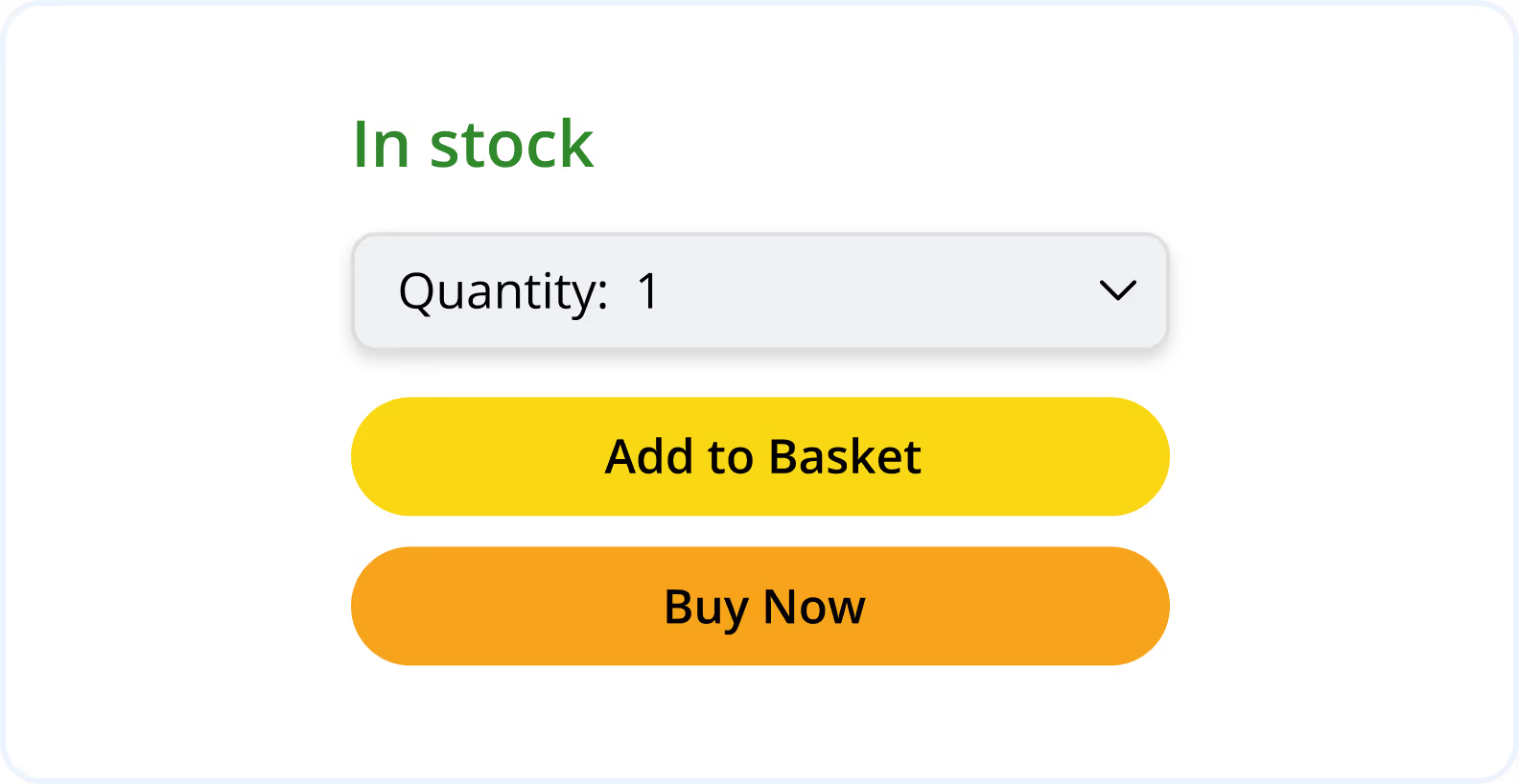
Stronger Retention
Most companies cannot make a significant profit on the first purchase. Unless your transaction values are very high, the chances are you will spend more on the acquisition and service of the first order. So it is crucial to keep your customers, whether it is on a subscription or by having them come back for more down the road. By ensuring their customers have a great experience first, XLG companies see their customers come back again and again. XLG companies frequently have thriving loyalty programs that, in some cases, generate more profit than the purchases.
Costco is well known as one of the global leaders in grocery retail. Their model is based on charging razor-thin margins on each product to offer the lowest prices in the industry. Here is an example of a membership-only model from Costco:
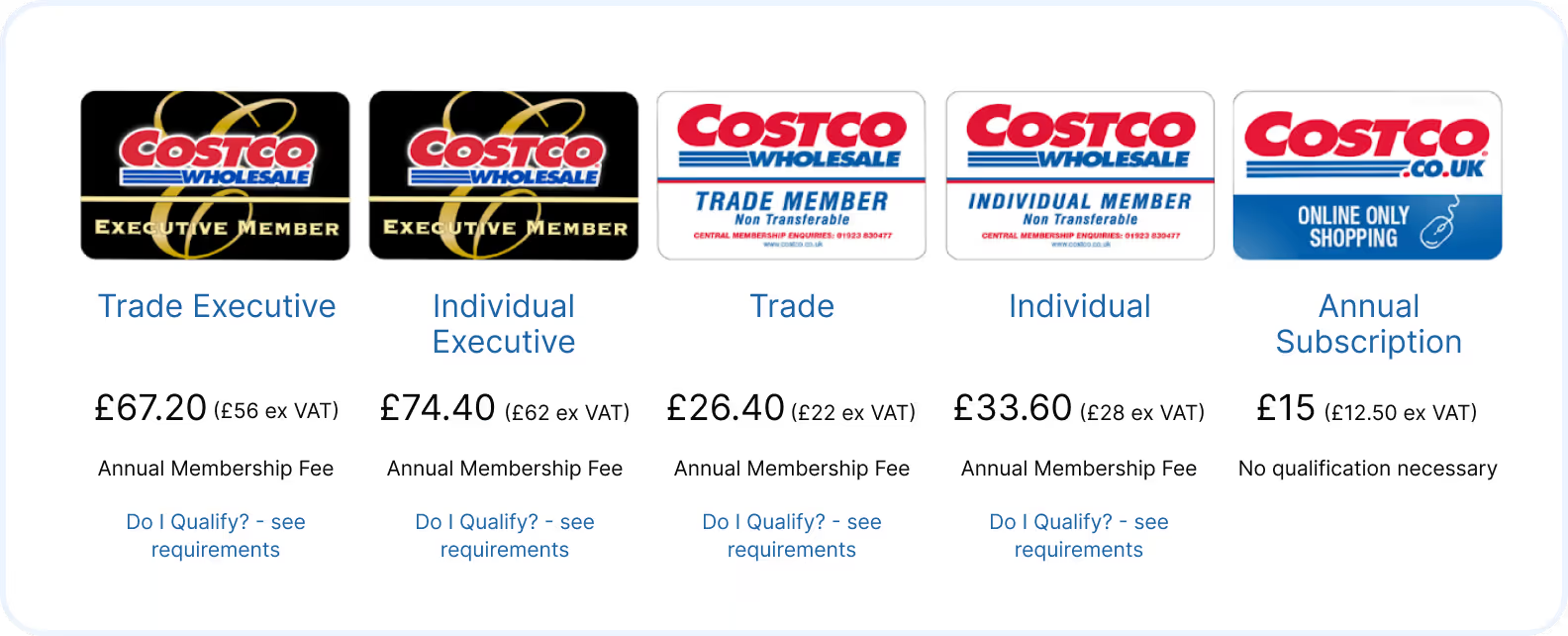
In 2023 revenue from Costco's membership fees was $1.082 billion during the quarter, up from $1 billion in the same period in 2022. The company's stock is up 41.9% in 2023, outpacing the S&P 500 index's SPX gain of 22.8%. Costco is profitable because it complements its low prices with a hugely successful membership program that generates revenue at a high profit margin.
Higher Prices, Cross Sell, & Upsell
Whether we like it or not, your product will resonate more with some customers than others. For most businesses, customers are not created equal, and figuring out the best customers and growing share of wallet with them is the easiest path to longer-term profits. XLG companies, by keeping their key customers excited, can easily upgrade them into a premium offering (which usually comes with a higher margin and lower churn) and sell them more products over their lifetime, meaning much higher profits per unit of acquisition cost.
Apple is a great example of this principle at work. Their products are often priced higher than competitors to begin with and they are very good at offering their customers upgrades and add-ons. Once you become an Apple customer, they further increase profit through additional products and services. You buy an iPhone, then suddenly, you have AirPods, a Mac, and an Apple TV subscription. Apple capitalized on the fact that people have a suite of Apple products, by making it easy to upgrade or enhance them with new accessories.
Here is a cross-sell and upsell example from the Apple iPad checkout:
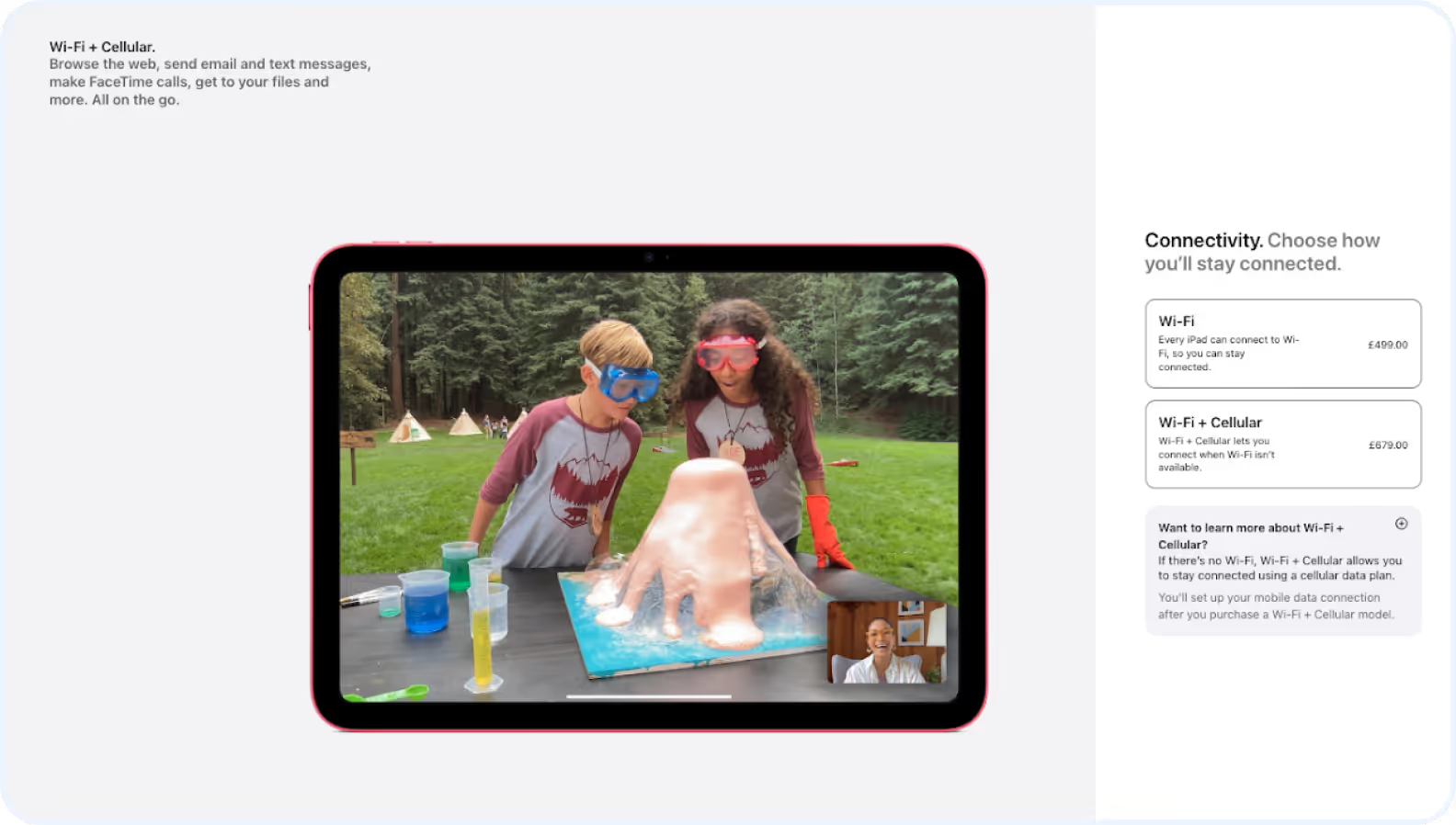
One of the best examples of this strategy comes from Tinder. They have recently introduced a new $500 a month plan, more than 20x the cost of their previous high tier. Tinder Select could cost users $6,000 for a year and will significantly impact overall revenue. This allows them to capture a huge additional profit margin from the top 1% of their customers.
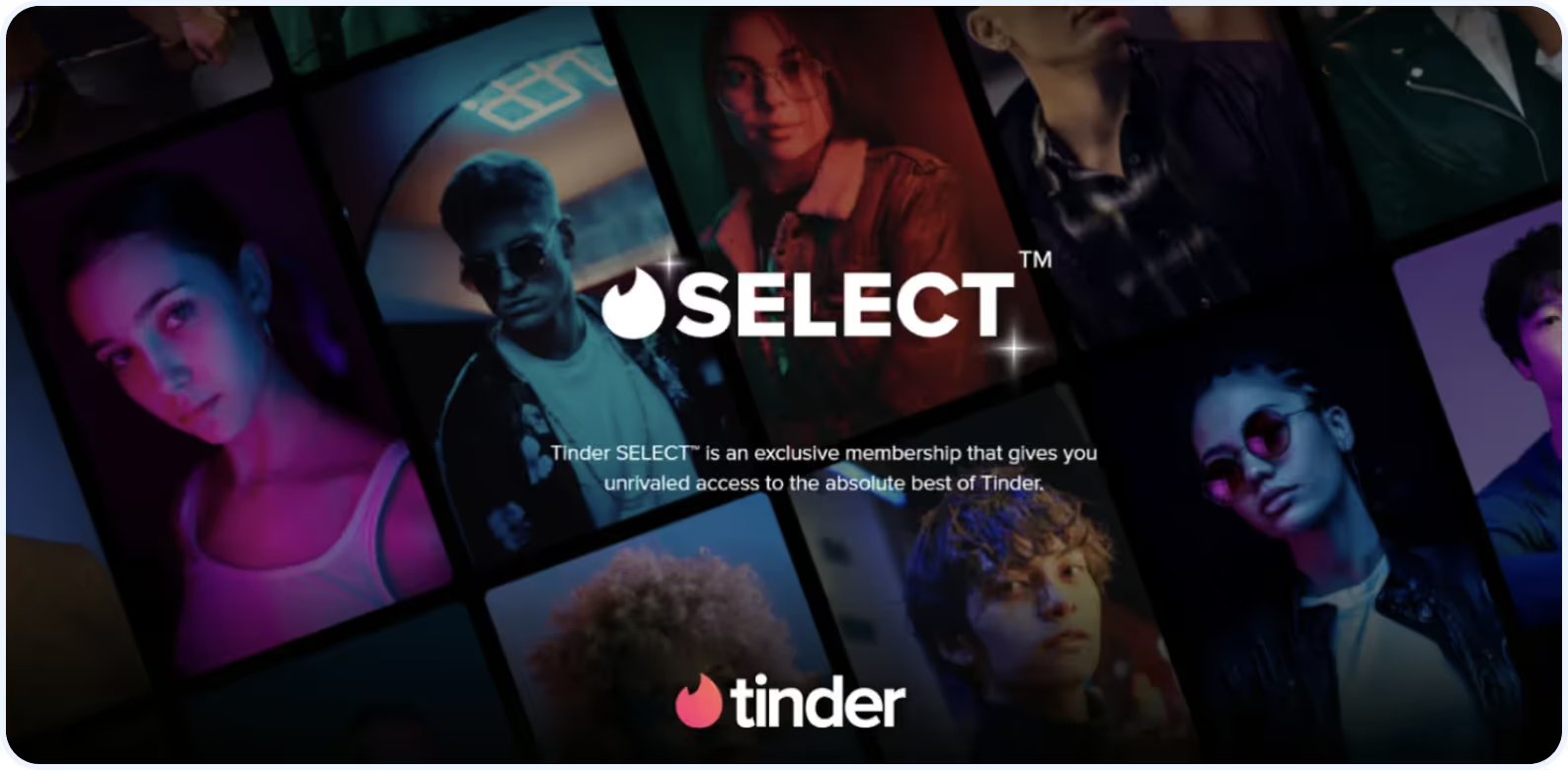
Lower Operating Costs
It’s great to grow the revenue impact of acquisition spend, but this would be a wasted effort if it came at the expense of much higher costs. Yet, counterintuitively, XLG companies frequently have lower, not higher, costs of service relative to their competitors.
This is because they have fewer cancellations, fewer returns, and fewer calls to their contact centers, which take less time to resolve. Basically, angry customers are expensive. And it turns out new technologies including AI often allow companies to both improve the experience and reduce the cost.
Put together, XLG companies get more profit for every dollar invested in customer acquisition over the long run. They can put these extra dollars towards both scaling and improving their CX. This makes them even more profitable, meaning that competitors find it harder to match them.
Too Many XLG Initiatives Fail in Practice
Many businesses agree with XLG even if they haven’t encountered the term before. But, oddly, few businesses have pursued this strategy coherently over a period of time. The reason for low adoption: management likes proven results.
As such, companies often end up with worsening customer experience as they scale and spend a lot more of their budgets on customer acquisition than on earning more profit from acquired customers. Because, whether we like it or not, in the corporate world, you need to prove results to continue making investments. With paid acquisition, measuring the impact of a dollar spent is relatively easy. Even when the ROI is not that high, it is clear. This makes it very easy to argue for maintaining or even growing budgets year or over year.
By contrast, most companies struggle to measure or prove the ROI of customer experience spending for three reasons:
- Detailed customer experience data is challenging to assemble in one place and even harder to work with using traditional tools.
- Without analysis, companies cannot estimate the relative impact of CX initiatives, both fixing problems and investing in differentiators at any point in time.
- And as a result, they struggle to build conviction about the dollar impact of CX spending.
Without a clear ROI framework, only companies with extreme strength of conviction around customer experience can execute XLG strategy over the long term. This conviction usually has to be baked into the very foundation of the business and come from strong founders or CEOs. Steve Jobs and Jeff Bezos have both had to push through a lot of resistance to instill customer experience as a critical priority in and of itself.
Most of us do not have a Steve Jobs character. But the truth is that - even for exceptional companies - it gets harder and harder to maintain XLG adherence as they scale because customer experience decisions are made all across the organization.
The other problem is that there is no standard approach to building a strong customer experience. In fact, XLG can demand completely opposite decisions from companies in the same industry. This is because it means understanding what your customers value the most and continuously driving improvement. Arguably, this is actually what makes XLG so exciting - once you get really good at it, it’s impossible to copy.
A key problem is that there is no by-the-numbers approach to building a strong customer experience. You can’t just adopt a set list of “best practices” and call it a day. In fact, XLG can demand completely opposite decisions from different companies, even in the same industry. XLG means understanding what YOUR customers value the most and continuously driving improvement.
There is, however, a framework for making XLG work continuously and at scale. Alongside attribution and conviction, companies need to focus on:
- Developing an XLG framework to guide operations
- Building user skills through certification programs
- Providing a dedicated community for peer networking and events
Fortunately, we don’t all need to be Steve Jobs or Jeff Bezos to succeed at XLG - there is a way to make it work for your business.
What an Ideal XLG Solution Looks Like
The decision to implement XLG is driven by your chances of success. By implementing an XLG acceleration program, you can build on software capabilities to achieve results and prove ROI. XLG often fails because businesses don’t build the frameworks, skills, and communities they need to achieve profitable growth.
Let’s take a look at the three core elements you need to accelerate XLG success:
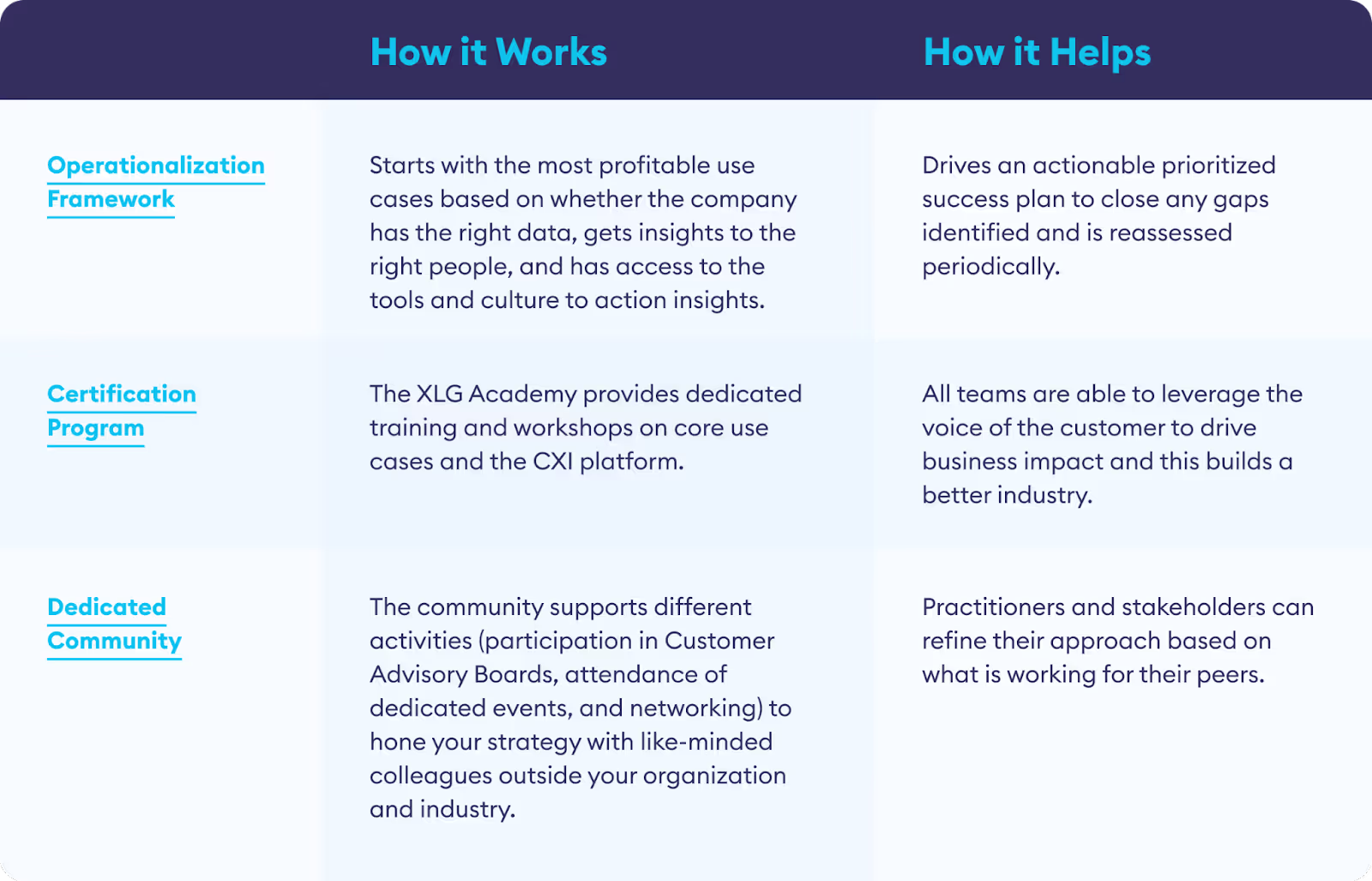
So, take an XLG approach to your growth. Ground it in your business goals. And you’ll not only gain profitability, but you’ll also create an approach that powers sustainable growth that everyone believes in.
Companies That Have Used Chattermill for XLG
XLG is the key to driving long-term profitability and boosting your internal alignment. Not only can you scale the adoption of the voice of the customer in your organization, but you can quantify the impact of changes on use cases like retention or acquisition.
Let’s look at a few ways Chattermill customers are winning with XLG.
Enterprise-Wide Use Cases
HelloFresh - the leading recipe box delivery service - adopted Chattermill’s CXI to drive customer experience across ten use cases in multiple business functions.
Steve Crolic, Associate Director, Voice of the Customer at HelloFresh, says, “We always know in any given market what the main priority areas are – what people complain about the most but also what are the biggest in terms of impact….We try to tie that to the financials we have.”
The results? They saw a 30% increase in average order value and a 4% increase in average number of orders per customer.
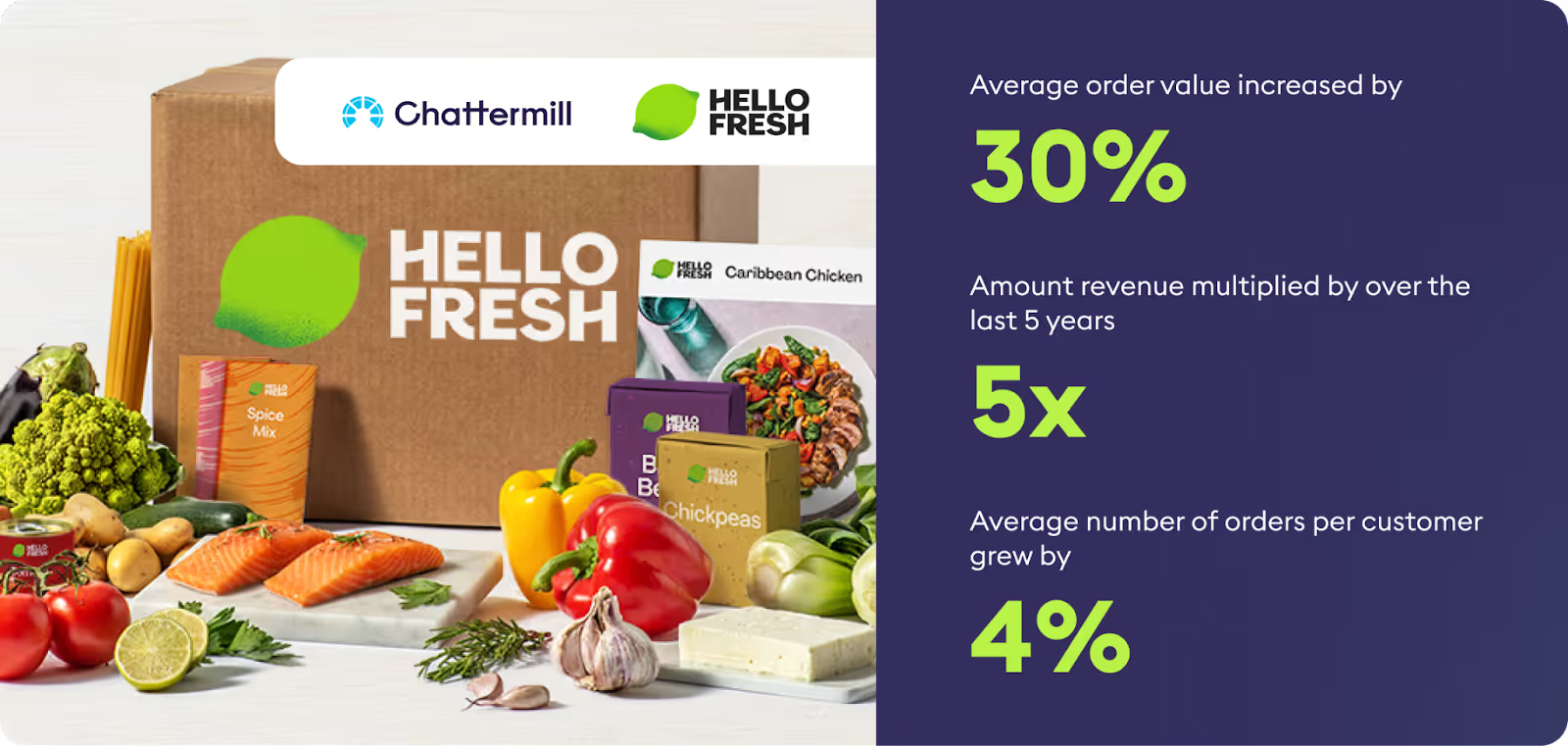
Reducing Product Returns and Driving NPS
A large eCommerce fashion retailer teamed up with Chattermill to delve into their return survey data and uncover the exact reasons behind product returns - a challenging task for an extensive inventory with over 1000 SKUs. Their goal for 2023 was to reduce their e-commerce return rate by 200 BPS and significantly boost their profitability per order.
The Senior Director of Customer Insights and Analytics, says, “Looking at one of our top-selling dresses, we discovered some customers expressed dissatisfaction with the non-adjustable straps, which were too long. As a top-selling item, the revenue from avoiding even half of these returns would cover the entire year's cost of using the platform, so we were able to show the return on investment for using Chattermill very quickly."
The results? The returns rate fell by 380 BPS on average per SKU, and the time it takes to understand return reasons fell from 6 months to 30 days. Their NPS improved by 53 points in some brick-and-mortar stores.
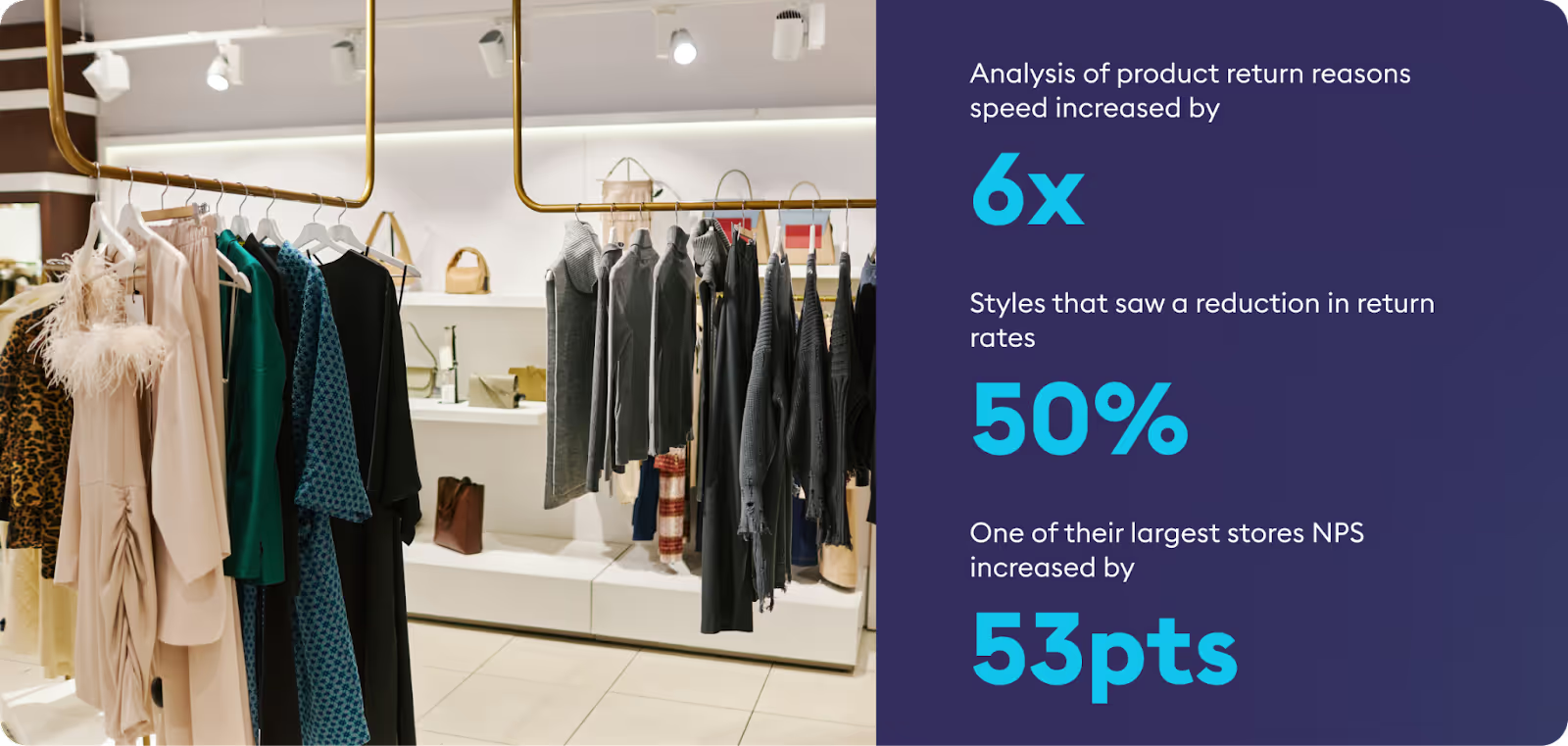
Boosting NPS
Providing a powerful customer experience is critical to generating long-term profits, and Wise - the international digital banking app - knows this first-hand. Wanting to drive its growth by word-of-mouth, Wise adopted Chattermill’s CXI to invest in its NPS score.
By enhancing their NPS scores based on customer feedback, Wise increased the viral impact of their word of mouth. The results? 60% of growth from word of mouth and over £2 billion transferred through the platform.
Nilan Peiris, Chief Product Officer at Wise, says, “Chattermill enables our team to take customer insights deeper than ever before and focus on the key factors that make a difference to our users and that drive our growth.”
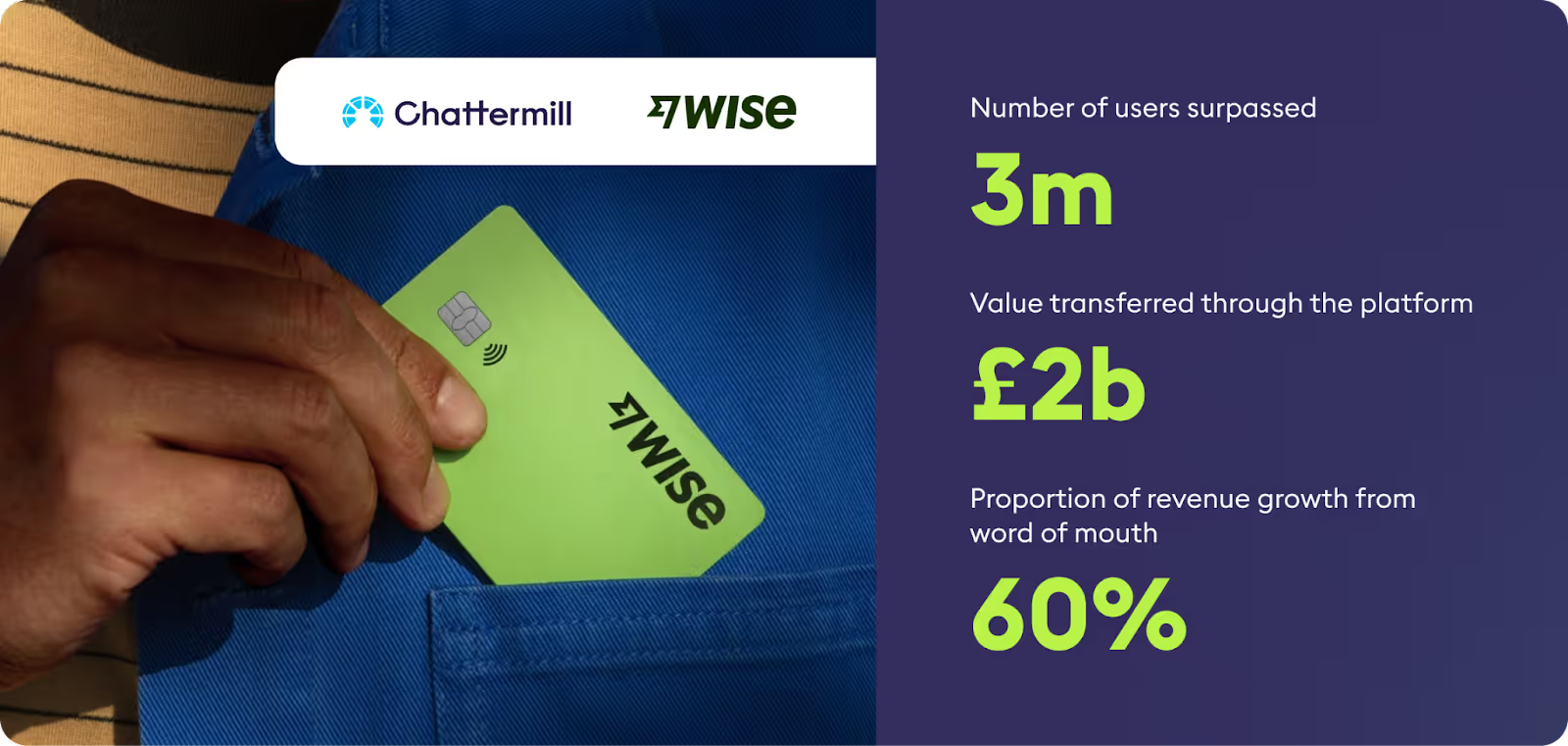
Align Your Organization Towards Profitable Growth
Although it may seem like paid acquisition provides a route toward growth, XLG is the way to align your entire organization for long-term profitable growth. It's about building a distinctive customer experience across the entire journey to support a sustainable profit engine.
By proving the value of CX and fostering a culture of continuous improvement, you can navigate the ever-changing market landscape and secure long-term growth. Soon, XLG will be a key pillar in any customer experience strategy. Because, when implemented correctly, it has the potential to prove ROI and turn exceptional customer experience into hard profits.
Experience-Led Growth FAQS
Here are the most common questions we get asked related to XLG:
I’m worried about manual analysis and lack of insights - how does XLG fit into this?
If you are analyzing customer feedback even manually you are already on your way to XLG, even if you don't look at it that way. XLG helps you frame your work as part of a bigger picture of how the customer insights that you find can help your company's business objectives and bottom line. This in turn can help you align with your stakeholders on why automating the feedback analysis would be a good investment as well as helping you understand the use cases that could benefit from customer insights in your organization.
How can I achieve XLG in practice?
Experience-Led Growth relies on creating a direct connection between the experience of the customer and your organization's business objectives. This is achieved by ensuring that each link in the chain is functioning effectively, not just as a one-off but on an ongoing basis. Our blueprint for delivering XLG explains the key elements and how to get started in more detail.
How long will it take until we see the business value?
For most organizations there are quick wins that can be implemented to start to unlock business value within the first few months. However, it is important to recognize that every organization is unique, and various factors - including an organization's current maturity - will impact how quickly value can be unlocked. Regardless of where you are starting from, the sooner you commence your journey, the sooner the benefits of XLG will be achieved.
Do we have the maturity in the organization to actually make this work?
There is no minimum level of maturity required to get started with XLG. We work with organizations that are at the beginning of their journey all the way through to those at the cutting edge. The power of the XLG maturity model is that it identifies the path to delivering XLG regardless of where an organization is starting from.
Looking to find out your maturity level? Check out our maturity assessment survey.
Do I have to overhaul my CX completely before starting with XLG?
It’s important to note that an Experience-led approach does not mean ripping up everything and starting again. However, operating on XLG principles avoids wasting time, money and resources focusing on the wrong things. It also removes the risk that internal stakeholders will lose faith in the importance of the customer experience as a result of the deployment of suboptimal approaches.





